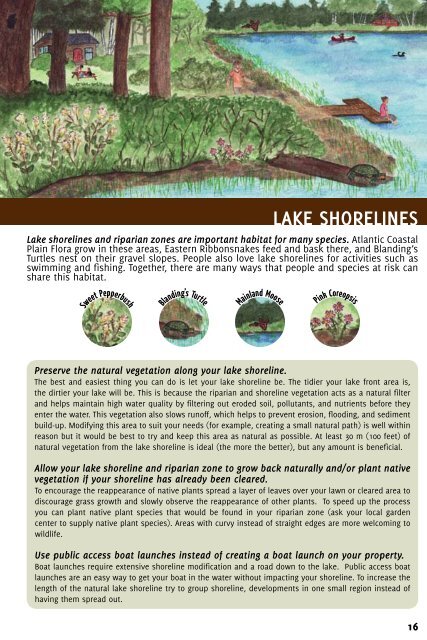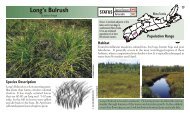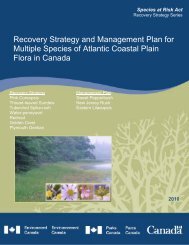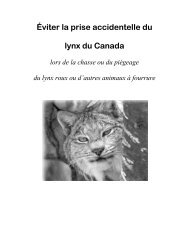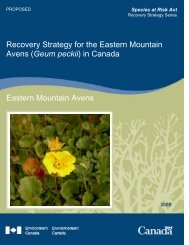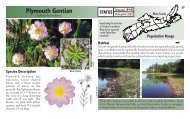Healthy Lakes and Wetlands For Tomorrow - Species at Risk
Healthy Lakes and Wetlands For Tomorrow - Species at Risk
Healthy Lakes and Wetlands For Tomorrow - Species at Risk
Create successful ePaper yourself
Turn your PDF publications into a flip-book with our unique Google optimized e-Paper software.
LAKE SHORELINES<br />
Lake shorelines <strong>and</strong> riparian zones are important habit<strong>at</strong> for many species. Atlantic Coastal<br />
Plain Flora grow in these areas, Eastern Ribbonsnakes feed <strong>and</strong> bask there, <strong>and</strong> Bl<strong>and</strong>ing’s<br />
Turtles nest on their gravel slopes. People also love lake shorelines for activities such as<br />
swimming <strong>and</strong> fishing. Together, there are many ways th<strong>at</strong> people <strong>and</strong> species <strong>at</strong> risk can<br />
share this habit<strong>at</strong>.<br />
Sweet Pepperbush<br />
Bl<strong>and</strong>ing’s Turtle<br />
Mainl<strong>and</strong> Moose<br />
Pink Coreopsis<br />
Preserve the n<strong>at</strong>ural veget<strong>at</strong>ion along your lake shoreline.<br />
The best <strong>and</strong> easiest thing you can do is let your lake shoreline be. The tidier your lake front area is,<br />
the dirtier your lake will be. This is because the riparian <strong>and</strong> shoreline veget<strong>at</strong>ion acts as a n<strong>at</strong>ural filter<br />
<strong>and</strong> helps maintain high w<strong>at</strong>er quality by filtering out eroded soil, pollutants, <strong>and</strong> nutrients before they<br />
enter the w<strong>at</strong>er. This veget<strong>at</strong>ion also slows runoff, which helps to prevent erosion, flooding, <strong>and</strong> sediment<br />
build-up. Modifying this area to suit your needs (for example, cre<strong>at</strong>ing a small n<strong>at</strong>ural p<strong>at</strong>h) is well within<br />
reason but it would be best to try <strong>and</strong> keep this area as n<strong>at</strong>ural as possible. At least 30 m (100 feet) of<br />
n<strong>at</strong>ural veget<strong>at</strong>ion from the lake shoreline is ideal (the more the better), but any amount is beneficial.<br />
Allow your lake shoreline <strong>and</strong> riparian zone to grow back n<strong>at</strong>urally <strong>and</strong>/or plant n<strong>at</strong>ive<br />
veget<strong>at</strong>ion if your shoreline has already been cleared.<br />
To encourage the reappearance of n<strong>at</strong>ive plants spread a layer of leaves over your lawn or cleared area to<br />
discourage grass growth <strong>and</strong> slowly observe the reappearance of other plants. To speed up the process<br />
you can plant n<strong>at</strong>ive plant species th<strong>at</strong> would be found in your riparian zone (ask your local garden<br />
center to supply n<strong>at</strong>ive plant species). Areas with curvy instead of straight edges are more welcoming to<br />
wildlife.<br />
Use public access bo<strong>at</strong> launches instead of cre<strong>at</strong>ing a bo<strong>at</strong> launch on your property.<br />
Bo<strong>at</strong> launches require extensive shoreline modific<strong>at</strong>ion <strong>and</strong> a road down to the lake. Public access bo<strong>at</strong><br />
launches are an easy way to get your bo<strong>at</strong> in the w<strong>at</strong>er without impacting your shoreline. To increase the<br />
length of the n<strong>at</strong>ural lake shoreline try to group shoreline, developments in one small region instead of<br />
having them spread out.<br />
16


